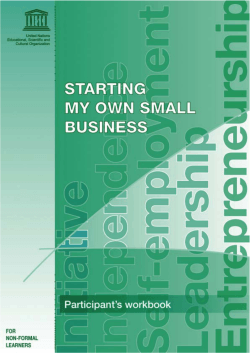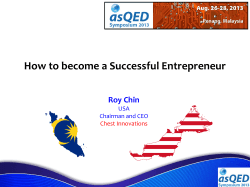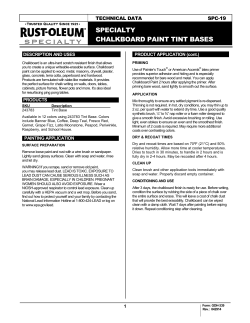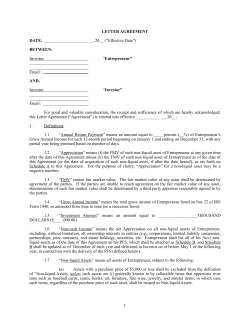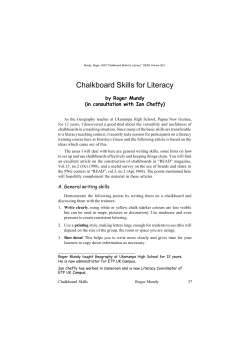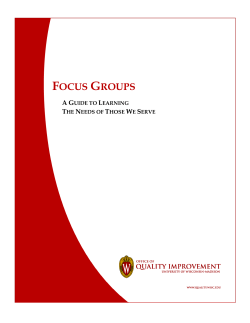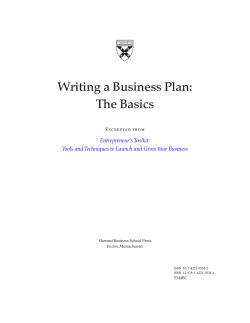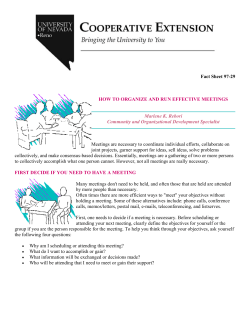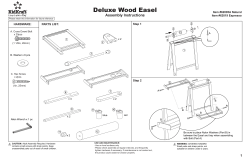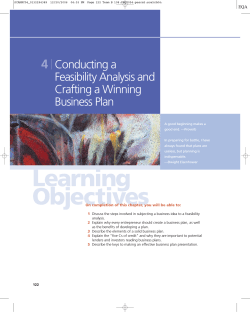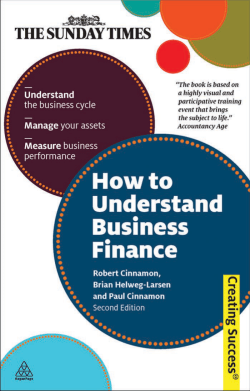
Document 166153
STARTING MY OWN SMALL BUSINESS A training module on entrepreneurship for students of technical and vocational education and training at secondary level Facilitator’s guide Foreword he Education For All (EFA) process, for which UNESCO is the lead Agency, has spurred considerable increases in primary school enrolments in many Least Developed Countries (LDCs). As more and more young people complete their primary education, governments are faced with the challenge of providing them opportunities for further learning – either in the form of general secondary education or alternative preparation for the world of work. T Many countries, particularly in Africa, consider that technical and vocational education and training (TVET) can equip young people with skills that enable them to engage in productive livelihoods. Yet in the past, TVET programmes have not led to increased employment, despite the obvious need in these countries for technical and vocational services. This has been due, in large part, to a dearth of wage employment opportunities for technically trained workers. UNESCO’s Section for Technical and Vocational Education is addressing this issue by proposing that entrepreneurial skills should augment the technical knowledge and skills young people gain in formal vocational training. Entrepreneurial skills will help them to acquire the mindset and know-how necessary to make self-employment a viable career option. Since there is currently little resource material available for teaching and learning about entrepreneurship at the secondary level, UNESCO has developed this prototype of a modular training package in entrepreneurship entitled “Starting my own small business”. It is my fervent hope that education authorities will utilize this training package to prepare secondary-level TVET students to start their 2 own small businesses. Empowering young people to become self-employed and engage in a productive livelihood not only helps them escape the trap of poverty, but also enables them to become active contributors in the economic and social activity of their community. UNESCO views the ability to engage in a livelihood as a vital life skill. Therefore, this training package in entrepreneurship may be considered a contribution towards achieving goal 3 of the EFA process – providing young people and adults with access to quality life-skills programmes. Peter Smith Assistant Director-General for Education UNESCO Paris, March 2006 3 Preface tarting my own small business is a prototype modular training package in entrepreneurship that is intended to provide supplementary knowledge to young people receiving technical and vocational education and training (TVET), in formal or non-formal settings, so that they may acquire an entrepreneurial mindset and the knowledge to set up a small business, if they so wish. S The training packages have been developed as a result of numerous requests from high-level education policy-makers in developing countries, particularly in Africa, who have bemoaned the lack of employment opportunities for the technically trained, while at the same time the availability of technical services was very limited. They were convinced that young technically trained people needed to become self-employed as independent service providers rather than depend on finding wage employment. Young people would then be able to satisfy the demand for those services while carving out profitable careers for themselves. Yet, there was little available resource material on entrepreneurship that could augment TVET. This led UNESCO to hold two workshops in Lusaka, Zambia and Kampala, Uganda bringing together TVET policy-makers from 11 East African countries to design modular training packages in entrepreneurship for higher secondary TVET learners and for non-formal learners. Following their guidelines and in close consultation with a core group of the workshop participants, UNESCO’s Section for Technical and Vocational Education developed these prototype training packages for the two groups of learners. The training packages are elementary and are intended to be an introduction to ethical entrepreneurship. They make no claim to be a complete resource material on starting a small business. Rather, they are core programmes that outline the key topics on entrepreneurship and may be expanded or abbreviated as the teaching situation demands. They also aim at instilling a heightened sense of self-confidence, particularly among non-formal learners, and awakening them to the possibility that self-employment could be a viable career option. Launching a successful business requires an awareness of one’s knowledge, skills, abilities, aptitudes, values and preferences. The training therefore begins by inviting students to consider their own strengths and weaknesses in these areas, so that they develop a clear sense of themselves. They are encouraged 4 to perceive themselves as the actors responsible for their own lives. Learners are then guided through the various stages of developing a commercial idea, from identifying a community need for a product or service to acquiring resources, organizing a workplace and marketing the product or service and finally preparing a business plan. At each step, the learner is encouraged to discover how his or her skills may be utilized to cater to a need in the community. While encouraging independent thought, creativity and initiative, the training demonstrates the benefits of collaborative work by treating selected topics as group activities. Finally, a section on the use of information and communication technology (ICT) in a small business enables facilitators to introduce these concepts to the extent that is relevant. The rapid spread of ICT usage lends this topic increasing significance. Such a discussion may also help to dispel the mystique that may persist in the minds of some learners regarding ICT. For learners completing secondary-level education, the training may help to make the transition from the structured atmosphere of the school to the world of work. For some non-formal learners it may provide the keys to a livelihood and for others it may lend legitimacy and system to work they are already doing. By promoting economic self-reliance and the need to play a constructive role in the community, the training also aims at human capacity building, a key element of sustainable development. Furthermore, empowering young people to engage in productive livelihoods is consistent with the first of the Millennium Development Goals, which is concerned with poverty eradication. Each training package consists of two parts – a facilitator’s guide and a participant’s workbook. Facilitators may adapt and interpret the training material to suit the unique situations in each community. The packages may be translated into local languages and reproduced without restriction, provided UNESCO is acknowledged as their source. Section for Technical and Vocational Education UNESCO 5 Note for Facilitators his prototype training package in entrepreneurship is designed to encourage students of technical and vocational education and training at the secondary level to consider self-employment a viable career option. It attempts to achieve this objective by ensuring that participants acquire an entrepreneurial mindset and some of the basic skills required to start a small business. As the facilitator, you are expected to support the participants’ development as entrepreneurs T by attentively guiding them through the course and helping them to amplify their latent entrepreneurial skills, to plan a small business and to realize that they can play a significant role in their community’s economy. You are also expected to provide participants with all the relevant literature available locally on starting a small business. Your role as the facilitator includes helping participants to understand that they must develop attitudes conducive to generating independent initiatives that draw on their technical education to build livelihoods for themselves. You must therefore ensure a freely interactive atmosphere and emphasize that participants are full partners in this exercise. Each participant should feel that she or he can make a valued contribution towards the effectiveness of the course. Participants need to be aware that as beneficiaries of secondary education, they are likely to be leaders in their community, playing an active economic role. They must therefore become familiar with the local business climate and expand their knowledge about specific local business activities. 6 Finally, it must be emphasized that this package is not a set of inflexible rules. On the contrary, it should be considered a set of guidelines that may be adapted at any stage to locally prevailing conditions and situations. Material may be added to the package or reduced from it according to the needs of the participant group and its local context. Practical hints The facilitator should introduce the participants to the advantages and disadvantages of operating in teams. In working through this course, participants may find it more effective to form groups of two or three, so that each group can initiate a business idea that they will assess and develop into a business plan by the end of the course. You should ensure that harmonious groups comprising complementary personalities are formed in order to facilitate efficient learning. The groups should also make the most of the diverse aptitudes of the different individuals to achieve synergy in the final outcomes. This practical approach should generate enthusiasm by engaging participants in a creative exercise that is relevant to the economic life of their community. It can also ensure that there is an immediate benefit from the training, in the form of a preliminary business plan. N.B. The terms ‘client’ and ‘customer’ are used interchangeably. When either the term ‘product’ or ‘service’ is used, the other is also implied. 7 Contents TOPIC 1: MY WINDOW ON THE WORLD OF SELFEMPLOYMENT 9 Unit 11 What is a business? Unit 12 Who is an entrepreneur? 10 11 TOPIC 2: DEVELOPING MY ENTREPRENEURIAL SKILLS Unit 03 Unit 04 Unit 05 Unit 06 Managing my own business Communicating Making the best use of my time Practising business ethics TOPIC 3: GETTING STARTED Unit 17 Unit 18 Unit 19 Unit 10 Unit 11 Unit 12 Matching my skills with business Assessing demand Sizing up the market Estimating cost and setting a price Observing rules and regulations Managing my workplace TOPIC 4: MOBILIZING RESOURCES Unit 13 Financial resources – How I find and manage my money Unit 14 Human resources – Hiring people to work with me Unit 15 Material resources – The things I need 13 14 15 16 17 18 19 20 22 24 25 27 28 33 35 TOPIC 5: MY FIRST STEPS IN THE BUSINESS WORLD 37 Unit 16 Compiling my business plan 38 TOPIC 6: INFORMATION AND COMMUNICATION TECHNOLOGY (ICT) Unit 17 Contacting my clients and partners with ICT Unit 18 The Internet and e-business LEARNING OBJECTIVES 8 12 39 40 42 44 Topic 1 My window on the world of self-employment This topic introduces a few basic concepts in business. 9 Unit 1 What is a business? Q Start the session with a description of the objectives of the course. Q Ask the participants to introduce themselves. Q Explain that the success of the course depends on their willingness to contribute and interact with each other in the class. Q Discuss what they expect from the course. Businesses are activities that provide goods and/or services in exchange for money or other goods and services. A variety of businesses contribute to our local economy. These include: X designing (buildings, gardens, paths, posters, etc.) X manufacturing or producing (goods like clothing or furniture, or parts of goods to be used by others to make complete goods, such as processing paper to make books) X supply and distribution (moving goods from producer to client) X selling (retailing – buying from a producer or another intermediary business and selling to the consumer, or wholesaling – buying from a business and selling to other retailers or repair businesses) X installing (fitting or connecting the product to the customer’s home or business) X repairing (restoring broken or defective goods to working order) X service industries (tourism, information and communication services, leisure activities, etc.). Q Ask participants what type of businesses are found in their community. Q Ask them to give examples of each of the types of business listed above. 10 Unit 2 Who is an entrepreneur? Q Define an entrepreneur: An entrepreneur is someone who starts or operates a business venture and assumes the responsibility for it. He or she provides goods or services to individuals or businesses for payment. CLIENT ENTREPRENEUR GOODS AND/OR SERVICES Some personal qualities entrepreneurs have include: X curiosity and creativity X motivation and self-confidence X willingness to take risks X eagerness to learn X ability to co-operate X ability to identify opportunities X ability to innovate (do something that nobody has done before) and lead X determination to overcome obstacles (‘never take no for an answer!’) X ability to learn from mistakes made by oneself and others, etc. These qualities help the entrepreneur to think, analyze, solve problems and take action. Not every entrepreneur will have all of the above qualities. Many of these qualities are latent within us and we may not even be aware that we possess them. They can also be acquired through the learning process. Q Ask the participants to list their entrepreneurial qualities. Q Ask them to suggest any other qualities they feel are needed for entrepreneurship. How do these qualities help an entrepreneur? How do they function in combination? Q Ask students to identify local entrepreneurs and the qualities they appear to have. 11 Topic 2 Developing my entrepreneurial skills The aim of this topic is to provide a positive image of business activities and to develop in students the key skills to run their own business. These skills can be developed from the entrepreneurial qualities discussed in the previous unit. At this point in the course, participants should begin to think of themselves not merely as young people with technical and vocational skills, but as people offering a service that their community needs and for which it is willing to pay. 12 Unit 3 Managing my own business People who start their own business have control over what they do in their working life. By managing their own business, they have the opportunity to shape their work environment and make an impact on their community. But often there will be resistance, especially if a new business idea is introduced. Therefore, one needs management skills to make the business successful as well as to convince the community that it can only help them, or at least can do them no harm. A good manager is a planner, a person who has vision, sets goals for achieving that vision and ensures that the necessary resources, financial and human, are obtained and allocated in time. Q Explain that the skills that will be discussed in this course need to be combined to build good management skills. Some key qualities good managers have: X reliability X integrity (financial and ethical) X ability to lead X ability to set a goal and work towards it in small steps X eagerness to meet obligations, etc. Q Discuss what other qualities a good manager should possess. Q Discuss any project participants have planned and implemented in several steps. 13 Unit 4 Communicating Good communication in business is important, because clients and business partners need to understand precisely what you are trying to buy or sell. Businesspeople need to be cheerful, keen, polite and helpful. Entrepreneurs should show interest in the customer and listen carefully to find out as much as possible about his or her needs. Listening is an important part of communicating. The entrepreneur needs to inform clients and business partners about the products and/or services they are selling and how these can meet their needs. Being honest and frank about our product or service can help build clients’ trust and confidence in us. This means that we should not give the client an incorrect impression of our product. Being frank in general may also help us to buy materials or services at a reasonable price from our business partners. Q Ask the class to select a product or service. Ask two students to role-play a conversation between a customer and a businessperson. The client should describe his or her needs, which may or may not be satisfied by the product. The businessperson should clearly describe the product or service and its uses, and explain how the product can be adapted to suit the client’s needs. Ask the students to point out strengths and weaknesses in the dialogue and how the weaknesses may be overcome. Q Select another product or service and repeat. 14 Unit 5 Making the best use of my time Managing time is an essential part of good business planning, because time is a resource that has a monetary value. Poor time management usually leads to lastminute rushes to meet deadlines, causing stress and inferior performance. This may result in a product or service of poor quality and/or it not being delivered in time. A disappointed customer may seek a more reliable business provider. Time should be allocated to tasks depending on: X when the product or service is to be delivered X how long the preparation of the product or service is likely to take X the need to co-ordinate people working on the product or service preparation X how important the product or service and the client are to the business as a whole, etc. Good time management allows for contingencies beyond our control, such as bad weather. Often, we must undertake several tasks at the same time in order to complete our job. We do this by estimating the amount of time necessary for each task and organizing our work accordingly. This is true of many of the activities that we take on in our everyday lives. For example, when we cook we do not prepare one dish after another. Rather, we carry out our chopping, mixing and boiling up in such a way that all our dishes are ready to serve up just when we want them! Similarly, a person working on a task may be asked to help with another task when the work situation requires it. The time taken for the various stages of production should be recorded, so that clients can be given estimates of delivery time and the timeframe of future projects may be planned. Q Ask participants to select a product (or service) and do the following: X List the tasks involved in the preparation of the product to the point of delivery. X Estimate time needed for each stage of production, leaving a small margin (approximately 10%) for unforeseen contingencies. X Determine how different stages of production can be run simultaneously and draw up a time plan. Q Select another product or service and repeat. 15 Unit 6 Practising business ethics Businesses need to function according to established law and rules set out by the community as well as the prevailing ethical standards (see unit 11). Investors, lending institutions and customers pay close attention to the standards of practice of businesses. But most importantly, young entrepreneurs may wish to set their own high ethical standards. In addition, many groups of businesses have established ethical standards for specific businesses. These standards of practice are a core set of values, developed by that group of businesses, that govern the relationships between business and customers. Although they are not legally required, these values help to provide levels of service that distinguish the best businesses and build confidence among clients. Q Ask participants to list examples of good business practice and bad business practice, and their possible consequences for the business in relation to the client or other partners. Encourage them to think of issues surrounding: X conflict of interest X corruption and bribery X environmental responsibility X non-discrimination against others, for instance women, people with HIV/AIDS and people with disabilities X after-sales service X truthful advertising X fair treatment of staff X refusal to deal with illegal partners, etc. Q Discuss the advantages of adopting sound business practices. 16 Topic 3 Getting started This topic is designed to stimulate the participants to generate a viable business idea. This means identifying a need in the local community and using their skills to fulfil that need, in the process earning compensation for themselves in the form of a salary or payment. 17 Unit 7 Matching my skills with business We all have skills that we use in day-to-day life. We can use some of these skills (or a combination of them) to launch a viable business. There are different types of skills: X thinking (being creative, solving problems, making decisions, observing my surroundings, basing actions on needs and opportunities of the immediate context, etc.) X conducting myself (believing in myself, managing my life, being responsible, etc.) X interacting with people (working with others and accepting others irrespective of their cast, gender, social status, whether they have a disability or not, etc.) X my safety and survival (HIV/AIDS prevention, self-preservation, first aid, drug abuse prevention, etc.) X what I can do (repairing bicycles, cooking, making crafts, reading, singing, etc.). The skills that will help us in business are likely to be a combination of our personal (entrepreneurial) qualities and our technical knowledge and expertise acquired in school. Our skills should not be confined to traditional stereotypes. For example, girls may make good motor mechanics. Q Ask participants to list their skills, starting with the strongest. Ensure that they cover a broad range of skills, such as planning skills, personal skills, and health and safety skills, in addition to their technical skills. Then list the needs that they observe in the community that would require those skills. Q Ask them to match their skills with the needs in the community by drawing lines between their skills and the needs. 18 Unit 8 Assessing demand The first step in starting a business is to identify a need in the community. Estimating the size of that need is called assessing demand. Effort should not be put into any other part of business planning before demand has been assessed. Referring to the needs identified earlier within the community, ask the class to establish a list of methods and criteria they will use to assess demand for a product or service. These could include: X listening to people’s complaints about a need in the community X informal surveys in the marketplace X mail surveys / questionnaires X a need that is highlighted in the local newspaper or radio X local focus groups, etc. Q Ask participants to develop a survey to assess demand for the product or service. When information has been gathered, ask them to analyze it and classify it into demographic groups (for example age, gender, occupation, income status, etc.) to determine which segment of the community is asking for their product. Q Select another need and repeat. 19 Unit 9 Sizing up the market The people in the community who need our product or service and are willing to pay for it are the market. The market must be aware of the availability of the product or service and be able to obtain it. Helping the community to know about a product and how to obtain it is a marketing strategy. It makes sense for a business to have an effective marketing strategy. A marketing strategy must take into consideration: X the location of the business X advertising X packaging X the need for good relationships with other businesses X reputation in the community (‘word-of-mouth’) X competitors’ prices. The entrepreneur should be willing to adapt products or services to customer preferences, taking into consideration local safety and security regulations. A new product may have an initial period of high demand. However, a saturation point may be reached, and demand may stay stable or even decrease. A sustainable market is one in which demand keeps increasing or stays stable with a steady rate of replacement. Q Ask participants to estimate the market for their product or service over a period of time. What factors can influence demand? Q Ask them to design a marketing strategy. Q Ask them to list favourable and unfavourable locations for their business. 20 Unit 9 Sizing up the market GOOD LOCATIONS BAD LOCATIONS 21 Unit 10 Estimating cost and setting a price A product or service may be exchanged for money or for another product or service. Most businesses will want to make a profit on products or services sold. Profit is the difference between cost price and selling price. A part of the profit can be reinvested or used for expansion of the business. A reasonable margin of profit enables the business to continue and even expand. Fixing the selling price of a product or service must take into consideration the following: X cost of production (including your own salary) X overheads X profit. It is therefore important to accurately calculate each of these, so that the final selling price is realistic. Cost of production + overheads + profit = selling price Cost of production and overheads Calculate each component that goes into production and overheads carefully, and add them up. Labour and depreciation of equipment (when equipment loses its value over time) may also need to be taken into account. In calculating the cost of labour, the entrepreneur should set a wage that adequately compensates the workers’ knowledge and contribution, taking into account the experience and qualifications of the worker, prevailing basic wage rates, holiday pay, government tariffs and social security contributions. Paying a lower price for materials and/or production could enable the entrepreneur to reduce the selling price. 22 Unit 10 Estimating cost and setting a price Profit The entrepreneur should be careful in setting the level of profit made on the sale of a product or service, taking into account the relationship between demand for the product (how many people want it) and the available supply (amount of product available to be sold). If demand is great for the available supply, the price (and thus the profit) may be increased. If there is a large supply, but few people want to buy, then prices may drop. An excessively high price due to a big margin of profit will dissuade customers. When sales increase, profit margins may be reduced. This can enable the entrepreneur to lower the selling price, therefore allowing the business to ‘capture’ the market and even expand it. Q Select a product or service. Ask students to cost the production, overheads (electricity, etc.) as well as factors such as labour and depreciation of equipment. Ask them to set a profit margin and selling price. Remind students that the profit earned by a business may not be retained in its entirety. The business may need to pay taxes to the government or local authorities. 23 Unit 11 Observing rules and regulations The local delivering institution or organization is expected to familiarize the participants with the documents referred to in this unit. The aim is to inform the participants of the laws, rules and practices that apply when starting a business in the community. These may include, for example: X requirements for registering a business X laws that govern businesses X the legal classification of a business, e.g. co-operative, public liability company, limited liability company, etc. X the tax code for small businesses X professional codes of conduct relevant to specific occupations. The authorities may offer certain facilities and incentives to entrepreneurs starting a new business. These may take the form of: X grants to set up a small business X micro-finance X tax relief X legal aid X recognition in the community, etc. A businessperson from the local community may be invited to discuss with participants the rules that need to be observed when a new business is started. He or she could also describe the unforeseen obstacles that are encountered when starting a business. This session should be as interactive as possible. 24 Unit 12 Managing my workplace This unit introduces the importance of organizing the workplace and the need for basic safety measures. A workplace is where goods and services are produced or sold, such as a factory floor or shop. Good workplace management helps small businesses to become efficient by: X creating comfortable and safe working conditions X gaining space X reducing material damage and loss (wastage) X preventing work-related accidents. Workplaces must be kept clean and safe for workers and clients. The entrepreneur should pay particular attention to: X space X lighting and ventilation X material handling and storage X control of hazardous substances. Space Each worker should be provided with sufficient space to carry out her or his tasks without interfering with other workers or other ongoing processes. Lighting and ventilation High precision work requires appropriate lighting. Workplace windows must therefore be cleaned regularly to allow sufficient light to come through. Similarly, ventilation is important for good health, particularly where work is being carried out with machines, chemicals or raw materials. The work area should allow enough space for air to circulate. 25 Unit 12 Managing my workplace Material handling and storage Storing materials properly helps to avoid accidents and save time. Raw materials, semi-finished goods and completed products should be kept in separate areas. Some raw materials and products should not be exposed to the elements (bad weather). They should be stored indoors. Items that are not frequently used should be removed from the work area. Control of hazardous substances Substances likes organic solvents, paint and glue must be kept in covered containers. Whenever possible, less hazardous materials should be used. Hands should always be washed after handling such substances. Q Discuss: X What is a workplace? X Why must a workplace be well-organized and tidy? X What must we do to keep our workplace safe? 26 Topic 4 Mobilizing resources The resources usually needed to launch a new business may be broadly classified in three groups: financial, human and material. The entrepreneur may need to mobilize sufficient finances to initiate operations. Human resource support, on the other hand, may not be required in the initial stages if she or he can manage the work at hand alone. The entrepreneur’s innovative qualities are expected to help with finding finances and material resources, while a spirit of initiative and self-reliance is important in getting the business off the ground. 27 Unit 13 Financial resources How I find and manage my money Estimating the cost of launching a business When the nature of the new business has been decided, it will be necessary to estimate the cost of starting operations. These may include the cost of: X premises X utilities X equipment X initial stock X insurance, etc. Obtaining funds The funds for launching the business may be obtained from one or a combination of sources: X personal savings X family funds X community co-operative organizations X community financial syndicates X micro-finance organizations X post office X savings and loan associations X banks, etc. Banks offer a variety of financial facilities, such as: X current or cheque accounts X savings accounts X loan services. 28 Unit 13 Financial resources How I find and manage my money It may be necessary to open an account with a bank before you qualify to obtain financial assistance. Loans obtained from banks will involve repayment with interest. A new entrepreneur should investigate as many sources of funding as possible in order to secure the best terms and conditions for repayment. This means ‘shopping around’ for the most favourable interest rates and repayment conditions. Lending institutions may require evidence regarding the prospective business, such as a business plan, a guarantee and a contribution by the entrepreneur, before they actually disburse funds. Managing my money When funds have been obtained for the purpose of launching a business, the entrepreneur needs to be meticulous about keeping records of income on the one hand, and expenditures on the other. The entrepreneur’s financial records need to be reconciled with periodic statements that the lending institutions will send. The entrepreneur needs to be particular about making repayments, according to the schedule agreed on by the two parties, in order to avoid penalties and higher interest rates. Financial discipline is key to a successful business. Business accounts need to be kept completely separate from personal accounts. Income statement An income statement is a simple summary of the business’ cash generating ability. It should be prepared on a monthly basis and should contain at least the following information: X income (funds procured to start the business, such as the loan, and money earned by selling your product or service) X cost of materials (includes all costs incurred in buying materials) X operating expenses (own salary, labour costs, overheads such as electricity and water, etc.) X repayment of loan (capital + interest) X gross profit (the earning after cost of production, including the repayment of the loan, has been reduced from the money earned from sales) X taxes (the national government as well as local authorities may levy taxes on business operations) X net profit (the earnings of the business after taxes have been paid). 29 Unit 13 Financial resources How I find and manage my money Q Select a business. Ask participants to devise an income statement for the business. Cash flow statement A cash flow statement is important because it gives the entrepreneur an idea of the amount of liquid cash available in the business at any given time. It is prepared by recording all income received by the business on the one hand, and all expenditures incurred by the business on the other. The difference between the two will give an indication of the positive or negative cash flow situation in the business at the end of a given period. Q Ask participants to prepare a cash flow statement for their business. Balance sheet A business needs to prepare its balance sheet periodically, as an indication of the performance of the business. This information is of interest not only to the entrepreneur, but also to concerned organizations such as investors, lending institutions, suppliers of materials, staff, etc. The balance sheet is a summary of the business’ assets, liabilities and equity: X Assets are the premises, materials, equipment and stock owned by the business. X Liabilities are the financial obligations of the business, such as rent for premises, loan repayments, etc. X Equity is the difference between the monetary value of the assets and the liabilities. Q Ask participants to fill in a balance sheet. 30 Unit 13 Financial resources How I find and manage my money Cash flow statement Month 1 2 3 4 5 6 7 8 9 10 11 12 Total for year Outstanding at year end Cash sales Other income Total income Outgoings/costs Material costs Labour costs Overheads Marketing costs Loan payments Taxes Total expenses Cash flow value Cumulative cash flow 31 Unit 13 Financial resources How I find and manage my money Balance sheet Assets Current assets Cash in hand Total income Materials in stock Long-term assets Equipment Property Total assets Liabilities Current liabilities Outstanding debts Cost of outstanding repairs Taxes Long-term liabilities Bonds payable Mortgage Total liabilities Equity 32 Unit 14 Human resources Hiring people to work with me The entrepreneur may launch the business by himself or herself, and consider obtaining assistance as it expands and the workload increases. She or he may also launch the business as a sub-contractor for another business, and consider getting help when the circumstances of the business permit. Mobilizing people to help with the business will involve compensating those people with a fair wage that corresponds to their suitability (qualifications) for the job and the number of hours, days, weeks or months they will work. Hiring Before hiring workers, the business needs to identify clearly the nature of the work that is to be done and the professional qualifications and skills of the person who should be hired to do this work. Staff may need to receive training when they start work and then again periodically during their working life with the business. Relevant training may contribute to motivating staff and making them more productive. Productivity is the amount of work a person does in a fixed period of time. The entrepreneur should keep in mind that the wage is not the only cost associated with hiring people to help with the business. There may be dues to be paid to the national government and/or the local authority in the form of social security, health benefit payments and training. Workers may be hired to carry out the following functions in the business: X production X quality control X administration X transport X customer relations, etc. 33 Unit 14 Human resources Hiring people to work with me Outsourcing A business may choose not to hire an employee to do some of its work. It may instead assign the work to a person or agency outside the business for payment for that assignment only. For example, many businesses do not have permanent cleaning staff. Instead, they hire other businesses to provide cleaning services. An advantage of outsourcing is that the business can choose to terminate the services of the contracted person or agency if their performance is not satisfactory or their charges are excessive. The business may then hire another person or agency better suited to its needs. A disadvantage of outsourcing is that the contracted person or agency would feel no significant loyalty or commitment to the business, and would not be a part of the working of the business as a whole. Q Select a task that needs to be carried out within a business. Ask participants to identify the work that needs to be done and determine the professional profile of the person needed to do that work. 34 Unit 15 Material resources The things I need Starting and running a business requires materials. The materials a business needs will depend on the nature of its activity (the product or service it is providing), and of course its size (how many people it employs, how many clients it has and the amount of goods or services it provides). The entrepreneur must determine very carefully what items or types of materials she or he needs to best run the business, and in what quantities. A business needs two categories of items: 1) items that enable the business to produce its goods or offer its services 2) items to manage the administration of the business, such as pens, paper and a calculator (and eventually perhaps a computer!). How many or how much of each item is needed will depend on the size of the business and how many goods or services it aims to make available to customers. Some items will need to be obtained only once every few years, while others will need to be constantly renewed. For example, after initially acquiring several sets of drinking mugs, a restaurant will need to obtain new mugs only occasionally, as they break or their condition deteriorates. On the other hand, it will need to buy fresh food very regularly, or the customers will go hungry! Once the entrepreneur has decided on the necessary materials and their quantity, he or she must determine whether or not they are easily available. Materials can be obtained from a combination of sources: X community members such as agricultural workers X other businesses X council or local government, etc. Materials can be expensive, particularly if they have been transported long distances. Wherever possible, they should be obtained from the local community and its surrounding areas. 35 Unit 15 Material resources The things I need If the necessary materials are not easily available for a reasonable fee, it may be necessary to change the business plan slightly so that the entrepreneur works without that item or works with an alternative item that is similar, or will serve the purpose. Q Ask participants to list the materials they will need for their business. What types? And in what quantities? Where will they find them? Remember, transporting materials from far away to your place of business is expensive and not always reliable! How will they pay for them? 36 Topic 5 My first steps in the business world The participants will be expected in this topic to develop a simple business plan, drawing on all that they have learnt in this course. The business plan will be the practical culmination of their involvement in the course. It is also expected to give them the confidence to take a well thought out, firm step into the world of business. 37 Unit 16 Compiling my business plan The business plan is a necessary document for summarizing the entrepreneur’s business aspirations, securing legal authorization and mobilizing the resources to launch the business. It is required in order to: X obtain permission from the local authority or the Chamber of Commerce to set up the business X convince funding institutions to provide finance X rent a space for business premises X convince business partners to supply materials or services, etc. A business plan should consist of the following components: X title page (name proposed for the business, entrepreneur’s name, contact address and other co-ordinates) X summary of business objectives X table of contents X structure of the proposed business X intended product or service that is to be sold X marketing plan (based on a market survey) X financial plan X anticipated returns X other supporting documents, such as letters of recommendation, certificates of education and training, community service documents, etc. Q Ask the students to draft a business plan by reviewing the course from unit 1. For example, they should consider: X the identified need in the community X the size, nature and sustainability of the market X financial resource requirements X human and material resource requirements X formalities for registering and launching a business X marketing mechanisms X possibility of making a profit, etc. 38 Topic 6 Information and communication technology (ICT) Information and communication technology (ICT) can help to launch and manage a business efficiently. Even though certain ICTs may not be immediately available in some communities, it is important to have at least a basic knowledge of their potential to improve efficiency and expand a business. This topic introduces ICT in a progressive fashion, starting with the established technologies and leading to contemporary ones. 39 Unit 17 Contacting my clients and partners with ICT ICT will enable the entrepreneur to enhance efficiency in the business by: X facilitating communication X storing information X tracking inventories of stock X providing a medium for advertising, etc. Examples of commonly-used ICTs are given below: Telephone A telephone or ‘phone’ is used for communicating verbally with clients and business partners. Phones that are fixed in one place are called land lines or fixed lines. Phones that you can carry with you are called mobile or cell phones. Fax machine This is short for ‘facsimile machine’. This is a machine that allows you to transfer a copy of a document through the telephone line. Both the person sending the fax and the person receiving it need to have a fax machine. Sending a written message by fax is a good way to make sure that it is received as quickly as possible. If you are dealing with people far away, a fax can also be a less expensive means of communicating. A message sent by fax can confirm in writing anything that has been previously agreed verbally. Most new fax machines also include a phone. Radio Radio is a very effective way to advertise a business. It is relatively inexpensive and can reach a large audience. Some communities have a local radio service. The entrepreneur may use this service to advertise products or services by being interviewed on a radio programme. 40 Unit 17 Contacting my clients and partners with ICT The positive contribution of your business to the community can also be publicized via the local radio. Television A business may use the medium of television for advertising. However, it is an expensive form of advertising. The computer The computer can be used for: X word processing (writing letters or receipts) X storing information (financial data, customers’ addresses, etc.) X keeping track of inventories X reminder messages about product or service delivery dates X generating advertising leaflets and posters X generating financial statements, etc. Q Ask participants to carry out exercises as appropriate with the equipment available and the extent of the participants’ familiarity with them. 41 Unit 18 The Internet and e-business Q The Internet The Internet links computer networks together. To connect to the Internet, you must have access to the following: X a computer with a modem connected to a phone line X software that enables you to connect to the Internet X an Internet service provider account. The Internet can be used by a business in two ways: X sending electronic mail (‘e-mail’) X accessing the World Wide Web. The Internet is usually available 24 hours a day. This means that communicating across different time zones is easy. E-mail enables you to send and receive messages, pictures and sound on your computer. E-mail messages are sent and received almost instantaneously. This is an inexpensive way to contact people far away as sending a message may cost about the same as a local telephone call. The World Wide Web is a part of the Internet that carries millions of pages of information, in sections called websites (sometimes called a homepage). Each website carries information about a specific theme and may be updated regularly by its host or webmaster. A business may obtain helpful information by scanning or ‘surfing’ websites. Some websites, known as search engines, can help you to identify other websites and/or information of interest. A business can launch its own website to advertise its products or services. Advertising via the World Wide Web ensures that the business can be publicized throughout the world. In this way even a small business can advertise its products worldwide and attract clients who would not otherwise know about them. 42 Unit 18 The Internet and e-business E-business E-business or e-commerce refers to the process of buying and/or selling by using the Internet to locate the desired product or service, and to discuss payment. One of the advantages of e-business is that geographical distance does not present a problem for conducting transactions. The client may visit the website launched by a certain business and find a product or service that he or she needs. The client then communicates by e-mail with that business to order the product or service and to indicate the method of payment. A small business may find it extremely cost-effective to advertise via the World Wide Web, as launching a website is a relatively inexpensive process. Communicating by e-mail and scanning websites depends very much of course on the quality and efficiency of the local telephone network and electricity supply. Q Ask participants to carry out exercises as appropriate with the equipment available and the participants’ level of familiarity with them. 43 44 Programme: STARTING MY OWN SMALL BUSINESS Beneficiaries: Higher secondary-level students in technical and vocational education and training (TVET) Duration: Short semester Profile: Programme to be moderated by a facilitator. Instruction and interactive sessions to be conducted together. Rationale: To equip learners completing TVET with the self-awareness, knowledge and acumen to consider self-employment a viable career choice. General objectives: 1. Understand the concepts of business and entrepreneurship. 2. Know the skills that contribute to entrepreneurship and recognize them in oneself. 3. Know the basic requirements for launching a small business. 4. Know how to translate a commercial idea into a business plan. 5. Know how ICT can be used in a small business. Unit Specific learning outcomes Activities Resources GENERAL OBJECTIVE 1: UNDERSTAND THE CONCEPTS OF BUSINESS AND ENTREPRENEURSHIP 1. What is a business? 1.1 Know the objectives of the programme. 1A. Self-introductions. 1B. Establish ground rules. Facilitator’s guide and participant’s workbook. 1.2 Be aware of how the programme can benefit them. 1C. Discuss the overall objectives of the Flipchart/chalkboard. programme. Locally-available materials 1.3 Understand the basic dynamics of a 1D. Discuss what the learners expect to with businesses. commercial business. gain from the programme. 1.4 Know the various possible types of 1E. Introduce the basic principles in business. business. connected 1F. Discuss the various types of business in the local community. 2. Who is an entrepreneur? 2.1 Understand the concept of the entrepreneur. 2A. Introduce the concept of the entrepreneur. Facilitator’s guide and participant’s workbook. 2.2 Know the personal qualities needed for entrepreneurship. 2B. Discuss the personal qualities needed for entrepreneurship. Flipchart/chalkboard. 2.3 Recognize one’s own entrepreneurial qualities. 2C. Invite learners to identify entrepreneurial qualities in themselves. 2D. Discuss prominent local businesspeople and their entrepreneurial qualities. 45 46 Unit Specific learning outcomes Activities Resources GENERAL OBJECTIVE 2: KNOW THE SKILLS THAT CONTRIBUTE TO ENTREPRENEURSHIP AND RECOGNIZE THEM IN ONESELF 3. Managing my own business 3.1 Understand the importance of mana- 3A. Emphasize the importance of management. gement. 3.2 Know the elements of management. 3.3 Know the qualities of a good entrepreneur. 3B. Describe the elements of management. Facilitator’s guide and participant’s workbook. Flipchart/chalkboard. 3C. Discuss the qualities of a good manager. 3D. Discuss how a good manager would accomplish a complex task. 4. Communicating 4.1 Understand the importance of effective communication in business. 4A. Introduce the importance of good communication in business. Facilitator’s guide and participant’s workbook. 4.2 Know the elements of effective communication. 4B. Discuss the elements of effective communication. Flipchart/chalkboard. 4.3 Acquire elementary business communication skills. 5. Making the best use of my time 5.1 Understand that time has a monetary value in business. 5A. Introduce the concept that time has Facilitator’s guide and participant’s workbook. a monetary value in business. 5.2 Understand the concept of time management. 5B. Discuss time management. 5.3 Be able to carry out multiple tasks in a time-coordinated manner. Flipchart/chalkboard. 5C. Guide participants in role-playing the co-ordination of multiple tasks. Clock. 5D. Discuss the importance of efficiency. 6. Practising business ethics 6.1 Understand the elements of sound 6A. Discuss the elements of sound busi- Facilitator’s guide and participant’s workbook. business practice. ness practice. 6.2 Know the advantages of adopting sound business practices. 6B. Discuss the advantages of adopting sound business practices. Flipchart/chalkboard. GENERAL OBJECTIVE 3: KNOW THE BASIC REQUIREMENTS FOR LAUNCHING A SMALL BUSINESS 7. Matching my skills with business 8. Assessing demand 7.1 Know the range of skills needed in launching a small business. 7A. Discuss the range of skills needed in Facilitator’s guide and participant’s workbook. launching a small business. 7.2 Understand how these skills need to be combined with already-acquired TVET skills, to identify a suitable form of self-employment. 7B. Emphasize the need to match these skills with TVET skills in identifying a suitable form of self-employment. Flipchart/chalkboard. 8.1 Understand the concept of demand. 8A. Introduce the concept of demand. 8.2 Know several methods for assessing demand. 8B. Discuss several methods of assessing demand. Facilitator’s guide and participant’s workbook. 8.3 Be able to identify high-demand groups in the community. 8C. Guide learners in designing a survey to assess demand. Flipchart/chalkboard. Examples of surveys carried out locally where available. 8D. Assist learners in analyzing the survey to identify high-demand groups. 9. Sizing up the market 9.1 Understand the concept of the market. 9.2 Understand the functions of a marketing strategy in business and how that strategy is devised. 9.3 Be able to articulate a simple business strategy. 9A. Introduce the concept of the market. 9B. Discuss the role of a marketing strategy in business. 9C. Guide learners in designing a marketing strategy for their business idea. Facilitator’s guide and participant’s workbook. Flipchart/chalkboard. Examples of local marketing, e.g. advertisements (in newspapers, a post office board, etc.). 47 48 Unit Specific learning outcomes Activities Resources 10. Estimating cost and setting a price 10.1 Understand how the selling price is determined. 10A. Explain how the selling price is determined. Facilitator’s guide and participant’s workbook. 10.2 Know how to calculate accurately 10B. Guide learners in calculating the the cost of production and set profit cost of production and setting promargins. fit margins. 10.3 Understand the forces of supply and demand. Flipchart/chalkboard. 10C. Introduce the concept of the forces of supply and demand. 10.4 Know how to set the sale price and 10D. Discuss how sale price is set and understand how supply and demand how supply and demand can influence sale price, and hence profit. can affect price, and hence profit. 11. Observing rules and regulations 11.1 Know local rules and practices governing the start-up and management of a small business. 11A. Explain local rules and practices Facilitator’s guide and participant’s workgoverning the start-up and mana- book. gement of small businesses. Flipchart/chalkboard. 11.2 Know the facilities and incentives 11B. Discuss the facilities and incentives offered to new small businesses. available to new small businesses. Copies of rules and regulations as appropriate. Copies of other documents as necessary. 12. Managing my workplace 12.1 Understand the importance of organizing the workplace and practising safety. 12A. Discuss the importance of an or- Facilitator’s guide and participant’s workganized workplace and practising book. safety. Flipchart/chalkboard. 12.2 Know what factors contribute to an 12B. Discuss what factors contribute to organized workplace. an organized workplace. Any locally-available industrial safety material (pamphlets, brochures, etc.). 12.3 Know what factors contribute to a 12C. Discuss what factors contribute to safe working environment. safety in the workplace. GENERAL OBJECTIVE 4: KNOW HOW TO TRANSLATE A COMMERCIAL IDEA INTO A BUSINESS PLAN 13. Financial resources – How I find and manage my money 13.1 Know how to estimate the start-up costs of a business. 13A. Discuss how to estimate start-up costs for a small business. 13.2 Be aware of the various ways of 13B. Introduce the various ways of obtaining start-up funds for a business. obtaining start-up funds for a business. 13C. Discuss the importance of keeping 13.3 Be aware of the need to keep metimeticulous financial records. culous financial records, especially 13D. Guide learners in completing and keeping personal and business remaintaining income statements, cords separate. cash flow statements and balance sheets. 13.4 Know the functions of an income statement, cash flow statement and balance sheet. 14. Human resources – Hiring people to work with me Facilitator’s guide and participant’s workbook. Flipchart/chalkboard. Locally-available banking and accounting materials. 14.1 Know how to hire workers according to the work that needs to be done in a business. 14A. Explain that workers must be hired Facilitator’s guide and participant’s workaccording to the type of work that book. needs to be done. Flipchart/chalkboard. 14.2 Understand that workers are entit- 14B. Discuss the benefits that workers led to benefits (besides their salary), are entitled to (in addition to their salaries), including periodic training. including periodic training. 14.3 Understand the advantages and 14C. Discuss the advantages and disadvantages of outsourcing as opposed disadvantages of outsourcing as to hiring staff. opposed to hiring staff. 15. Material resources – The things I need 15.1 Know how to identify the materials 15A. Discuss how to identify the materials Facilitator’s guide and participant’s workneeded to produce the goods or needed to produce the goods or ser- book. services provided by a business. vices provided by a business. 49 50 Unit Specific learning outcomes Activities 15.2 Know how to identify the materials 15B. Discuss how to identify the mateneeded to support production. rials needed to support production. Resources Flipchart/chalkboard. 15.3 Be aware of how and where these 15C. Discuss how and where these materials may be obtained. materials may be obtained. 15.4 Understand that materials of the re- 15D. Remind learners that materials of quired quality need to be obtained the required quality need to be obtained at the lowest price from an at the lowest price from an ethical supplier. ethical supplier. 16. Compiling my business plan. 16.1 Know the importance of preparing a 16A. Explain the importance of preparing business plan. a business plan. Facilitator’s guide and participant’s workbook. 16.2 Know the components that consti- 16B. Guide learners in preparing a business plan. tute a business plan. Flipchart/chalkboard. Examples of local business plans. GENERAL OBJECTIVE 5: KNOW HOW ICT CAN BE USED IN A SMALL BUSINESS 1B. Contacting my clients and partners with ICT 1B.1 Be aware of how ICT can help a 1B.A Discuss how locally-available ICT Facilitator’s guide and participant’s workbook. can help a small business. small business. 1B.2 Be familiar with the traditional and 1B.B Discuss traditional and modern Flipchart/chalkboard. ICTs. modern ICTs used in small business. 1B.3 Know the functions a computer can perform. 1B.C Discuss how a computer can help a small business. 2B. The Internet and e-business 1B.D Demonstrate examples of locallyavailable ICTs. Locally-available ICTs as appropriate. 2B.1 Know the potential of the Internet for a small business. 2B.A Discuss the potential of the Internet for a small business. Facilitator’s guide and participant’s workbook. 2B.2 Understand how e-mail can help a small business. 2B.B. Discuss how e-mail can help a small business. Flipchart/chalkboard. 2B.3 Be aware of the potential of e-business. 2B.C. Discuss the potential of e-business. Computer linked to the Internet if available locally. 51
© Copyright 2025
